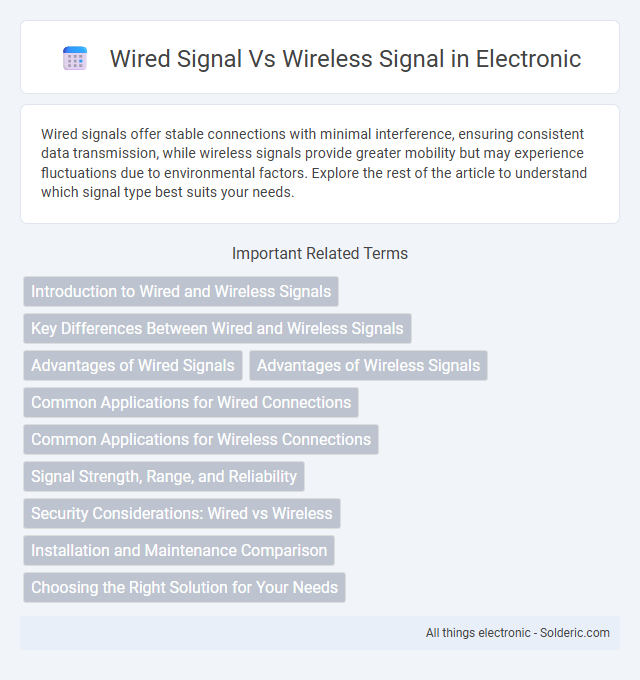Wired signals offer stable connections with minimal interference, ensuring consistent data transmission, while wireless signals provide greater mobility but may experience fluctuations due to environmental factors. Explore the rest of the article to understand which signal type best suits your needs.
Comparison Table
| Aspect | Wired Signal | Wireless Signal |
|---|---|---|
| Transmission Medium | Cables (Ethernet, fiber optics, coaxial) | Radio waves, microwaves, infrared |
| Speed | High speed, stable (up to 10 Gbps+ with fiber) | Variable speed, dependent on technology (Wi-Fi, 4G, 5G) |
| Signal Stability | Consistent, less interference | Prone to interference, signal drops |
| Installation | Requires physical cables, complex setup | Easy setup, no cables needed |
| Mobility | Limited by cable length | High mobility, supports device movement |
| Security | More secure, difficult to intercept | Vulnerable to eavesdropping, requires encryption |
| Cost | Higher initial infrastructure cost | Lower setup cost, but potential ongoing costs |
| Latency | Low latency, suitable for real-time applications | Higher latency due to signal processing |
Introduction to Wired and Wireless Signals
Wired signals transmit data through physical cables such as Ethernet or fiber optic, offering high reliability, low latency, and consistent bandwidth for stable communication in networks. Wireless signals use radio waves or other electromagnetic frequencies to enable data transmission without physical connections, providing mobility and ease of installation but often subject to interference and variable speeds. The choice between wired and wireless signals depends on factors like environment, performance requirements, and security needs in communication systems.
Key Differences Between Wired and Wireless Signals
Wired signals transmit data through physical cables such as Ethernet, offering consistent speed, low latency, and enhanced security ideal for environments requiring stable connectivity. Wireless signals use radio waves to transmit data without physical connections, providing greater mobility and ease of installation but often facing interference, signal degradation, and higher latency. Your choice between wired and wireless depends on the need for speed, reliability, mobility, and network security in your specific application.
Advantages of Wired Signals
Wired signals provide stable and consistent data transmission with minimal interference, ensuring high-speed connectivity for applications requiring reliability. Wired connections offer enhanced security by reducing the risk of unauthorized access compared to wireless signals susceptible to hacking. They also deliver lower latency, making them ideal for real-time communication and critical network functions.
Advantages of Wireless Signals
Wireless signals offer unmatched mobility and convenience, enabling seamless connectivity without physical cables. They support flexible network deployment and are ideal for remote or difficult-to-wire locations, enhancing user accessibility. Wireless technology reduces installation costs and allows easy scalability, adapting quickly to changing network demands.
Common Applications for Wired Connections
Wired signal connections are predominantly used in environments requiring stable and high-speed data transmission, such as office networks, data centers, and industrial automation systems. Common applications include Ethernet cables for local area networks (LANs), fiber optic cables for long-distance communication, and USB cables for peripheral device connectivity. These wired connections offer lower latency, enhanced security, and reduced interference compared to wireless alternatives.
Common Applications for Wireless Connections
Wireless signals are widely used in applications such as mobile communications, Wi-Fi networks, and Bluetooth devices, enabling seamless connectivity in smartphones, laptops, and smart home systems. These wireless connections provide flexibility, mobility, and ease of installation, making them ideal for environments where physical cabling is impractical. For your convenience, wireless technology supports IoT devices and remote monitoring systems, enhancing automation and real-time data access.
Signal Strength, Range, and Reliability
Wired signals provide consistent signal strength with minimal interference, ensuring stable and reliable data transmission over fixed distances. Wireless signals offer greater flexibility and mobility but can experience fluctuations in signal strength and reduced range due to obstacles, interference, and environmental factors. Reliability is higher in wired connections due to direct physical links, while wireless connections rely on signal quality, which can be affected by distance and surrounding elements.
Security Considerations: Wired vs Wireless
Wired signals provide enhanced security through physical connections that limit unauthorized access and reduce susceptibility to eavesdropping or signal interception. Wireless signals, while offering convenience and mobility, are more vulnerable to hacking, man-in-the-middle attacks, and signal jamming due to their broadcast nature. Implementing strong encryption protocols like WPA3 and using VPNs are essential to mitigate security risks in wireless communications.
Installation and Maintenance Comparison
Wired signal installation requires structured cabling, connectors, and often professional expertise, resulting in longer setup times but stable performance. Maintenance involves periodic inspections of cables, connectors, and hardware to prevent physical damage or signal degradation. Wireless signal setup is faster and more flexible, with fewer infrastructure demands, though it necessitates regular firmware updates and interference management to maintain signal quality.
Choosing the Right Solution for Your Needs
Wired signal connections offer stable, high-speed data transfer with minimal interference, making them ideal for environments requiring consistent performance. Wireless signals provide greater flexibility and mobility, supporting your dynamic lifestyle by enabling easy device connectivity without physical constraints. Evaluating factors such as signal reliability, installation complexity, and usage scenarios will help you choose the right solution tailored to your specific needs.
Wired signal vs wireless signal Infographic

 solderic.com
solderic.com